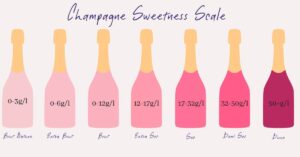Ever taken a stroll down the sparkling wine aisle and felt… lost? We have all been there, and we can’t blame you– unless you’re fluent in French and the Champagne method from day one of drinking bubbly, you’ve got to learn how to read the label. We’ve got you covered.
We will be detailing every aspect of a standard Champagne label so you can become a master Champagne shopper, and better yet, a master Champagne drinker.
“Champagne”
If you’re looking for Champagne, you’ll be able to find it by checking the label. This is an obvious statement, of course, but it truly is the first word you’ll need to find on the label to ensure you’ve got the real deal.
In many cases, you will see the word “Champagne” in small print at the very top of the label. The same goes for Prosecco, Cava, or any other region-specific sparkler, but only the word “Champagne” indicates that your bubbly was grown and produced in the Champagne region of France.
Champagne House or Producer
For most labels, the Champagne house will be towards the top in large text. Many houses rely on their name to get their bottles off the shelf– think Veuve Clicquot, Dom Perignon, or Moët & Chandon– so this aspect of the label is usually front and center to reflect its prominence.
Village or Location
The location of the producer house will be displayed on all quality sparklers. If you don’t see a village or region listed, it may be an indication that the bubbly is not of the best quality.
Brand Name, Style, or Tête de Cuvée
Don’t confuse this with the producer name, though it’s easy to conflate the two. The “brand name” references any particular line made by the producer. For instance, Taittinger offers Comtes de Champagne, Veuve Clicquot releases La Grande Dame.The brand name offers even more shelf appeal, because certain producers build a reputation around particular styles of bubbly that are staples in their repertoire.
You may find the style of Champagne along with the brand name, or in place of the brand name. For style, think blanc de blancs, rosé, or blanc de noirs. The style gives you insight on what grapes were used, and what the wine inside will look and taste like.
Sweetness Level

The next element of the Champagne label is the sweetness level. If there isn’t a style listed, this is your best glimpse into what the wine inside the bottle will taste like. Most bottles o’ bubbly are in the brut style, to accommodate modern taste, but you can find sparkling wines ranging from brut nature, extra brut, brut, extra sec, sec, demi-sec, and doux.
Year
If you see a year on your label, that means you have a vintage champagne on your hands! Don’t fret if you don’t see a year, that only means that your bottle is non vintage, which does not inherently mean that it’s of lower quality, it’s just a blend of cuvees from several different vintages. The vintage is the year that the grapes were harvested from the vineyard, but you may also see a date of disgorgement (typically on the back label).
The Tiny Letters at the Bottom
Once you’ve gotten through the bulk of the label, you’ll see some tiny characters located in the bottom corners of your label.
These will display the size of the bottle (in fluid ounces), the alcohol content, and the producer type. The producer type is conveyed in shorthand, let’s break it all down.
- RM (Récoltant-Manipulant) wines come from a “grower-producer” (a.k.a. vineyard owner), typically vinified on-site at the property. Grower-producers have control over their entire winemaking process, from grape cultivation to production and bottling. RM Champagnes often emphasize the expression of terroir and can provide a unique and distinct character compared to those produced by larger Champagne houses that source grapes from various vineyards.
- RC (Récoltant-Coopérateur) is a producer who grows grapes and gives them to a local cooperative, who in turn makes the Champagne and gives a portion, in bottles, back to the grower. The grower then sells the Champagne under his or her own label.
- CM (Coopérative-Manipulant) are groups of producers who pool their grapes together and make champagne under their various labels.
- NM (Négociant-Manipulant) is a producer that bottles and markets Champagne using grapes purchased from other growers. This reflects the traditional structure in Champagne that has existed for hundreds of years, whereby growers would own vineyards and grow grapes, selling them to négociants who would make the wine.
Finally, you’ve reached the end of the label! For all that hard work, congratulate yourself with a glass! Then, practice your new sparkling skills with our daily offer.
Cheers!
We'd love to hear your thoughts! Comments can be sent by email to cheers@lastbubbles.com!
